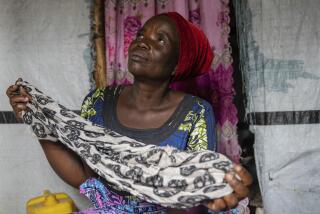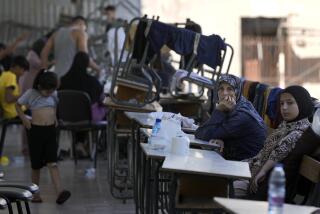Syria doctors risk their lives to secretly treat protesters
Reporting from Beirut — The young doctor got the call early in the morning. Troops were storming a neighborhood in the strife-torn Syrian city of Homs, and there was no one to treat the wounded.
“It was like a war,” said the doctor, who asked to be identified by a nickname, Abu Abdu.
That September day, he said, his covert medical team worked for 12 hours straight, applying bandages to gaping wounds, extracting bullets and inserting IV lines into about 20 patients as gunfire and explosions echoed around them.
When it was over, he said, he stepped into a shower to wash off the blood and cried for more than an hour.
Abu Abdu is one of dozens of volunteers in Homs and other opposition strongholds who treat victims of a government crackdown that has turned hospitals into instruments of repression, human rights groups say. They work out of secret, makeshift clinics in mosques and homes in neighborhoods where protests take place almost daily.
Activists say many wounded protesters refuse to be taken to public hospitals, where they fear they will be abused and arrested if they show up with bullet or shrapnel wounds. Authorities say they have nothing to fear.
But a report prepared for the United Nations Human Rights Council alleged that patients taken to the military hospital in Homs were tortured and killed by security forces dressed as doctors, apparently with the complicity of medical personnel.
A guard who used to work at the hospital told Human Rights Watch that wounded protesters would be unloaded in a yard next to the emergency area where staff members would be waiting. “Everybody would start beating them, including doctors and nurses,” he said.
A patient who was treated there told the group that nurses stitched up a bayonet wound to his back without anesthesia. Guards then took him to a detention facility on the premises, where he said he saw one of them heat a metal rod on a gas heater and burn a patient on his genitals and the soles of his feet.
Now those who treat the wounded have also become targets. This month, Dr. Ebrahim Othman, who helped found an underground medical network in Damascus, the capital, was reported killed, prompting an outpouring of tributes on social networking sites for the 26-year-old dubbed “the doctor of the revolution.”
Opposition activists said Othman was wanted by the authorities and came under fire as his driver tried to evade a checkpoint near the Turkish border. Video purporting to show Othman’s body was posted on YouTube. The authenticity of the video could not be independently verified.
Witnesses and rights groups say those who try to help wounded protesters frequently come under fire, charges denied by the authorities, who say armed terrorists are mixing in with peaceful demonstrators. A Red Crescent worker was killed and two severely injured when their ambulance was ambushed from four directions as they transported a man shot in Homs on Sept. 7, Human Rights Watch reported.
“Anyone who is treating the wounded is regarded as if they are carrying a gun against the regime,” said a member of the Homs Revolutionary Council who coordinates supplies for the city’s clandestine clinics.
The young man, who gave his name as Ahmed, is a medical student who said he worked at a government facility as part of his training. “I saw medical staff beat patients,” he said. “And when they are released, instead of being sent home, they are sent to detention.”
Even private hospitals aren’t considered safe. In August, a young protester named Safa was taken to the Barr hospital in Homs with shrapnel wounds from an explosion.
“My dad saw him in hospital,” said the man’s cousin Susie, who was reached in Montreal. “He was supposed to have an operation, but he was stable.”
The next day, she said, his bed was empty. No one could tell the family where he had been taken. Weeks later, the family received a call to collect his corpse from the Homs military hospital. Video of the body showed burns, bruises and gashes that left bone exposed.
“It was horrific,” said Susie, who asked that their last names be withheld to protect family members in Syria. “It’s supposed to be safe in hospitals.”
When Abu Abdu returned home in May after completing his medical studies abroad, he said, family and neighbors in Homs’ Old City were overjoyed to see him. Two weeks earlier, security forces had fired on thousands of protesters.
Abu Abdu learned from his father that “a lot of them died in front of his eyes and he cried because I [was] not there to help them.”
The doctor set up three makeshift clinics in abandoned homes in and around his neighborhood, which was then relatively safe but bordered hotbeds of opposition. They were staffed by volunteers, whom he trained in emergency first aid.
Patients would arrive by car, motorcycle and bicycle and were treated on the floor, he said. At first, all he had were bandages and gauze to try to stop the bleeding. But as he got to know others doing this kind of work, he said, he was able to get hold of basic surgical supplies, such as needles and scalpels.
Still, he said, there were many times when he did not have the equipment he needed.
“If it’s a big injury, we can’t do anything,” he said. “We just watch them die. It’s very hard.”
As troops started making inquiries about him, he moved from safe house to safe house, grateful to have so many friends. One evening, he heard a bullet whistle past his ear as he was working on a patient. The next day, he said, security forces raided the area looking for activists, including the doctor who was treating protesters. Abu Abdu escaped, but all of his clinics were found and destroyed, he said.
A few weeks ago, security forces caught up with the doctor. He was detained and questioned for two days. He said his interrogators accused him of treating people who had suffered weapons injuries. “I’m a doctor,” he told them. “My job is to help people; so what is the problem?”
To his surprise, he was released. But he is convinced that it is only a matter of time before he is killed. When he and his family say goodbye to each other, he said, “we mean it.”
Homs now has makeshift clinics in most areas where protests take place, said Ahmed, the medical supplies coordinator. They are concealed in basements, storage areas and apartments. But where the violence is too intense, the only treatment is provided by field volunteers equipped with basic first aid kits.
The clinics are financed by donations, Ahmed said. Supplies are smuggled in regularly from abroad, but getting them to the clinics is difficult, he said. Anyone found with medical equipment in his vehicle is subject to arrest. There are constant shortages of blood and sterilized instruments.
Patients with more serious injuries are sneaked across the border to hospitals in Lebanon through the same smuggling networks that bring in medical and other supplies.
On a recent afternoon in Wadi Khaled, a valley at the northern tip of Lebanon, a Syrian activist who gave his name as Wael sat on the floor of a safe house surrounded by wires and emergency batteries designed to keep him working through the regular power outages.
Skype messages pinged on his laptop. A call came in on his cellphone from a smuggler trying to flee Wael’s hometown, Qusair, with three patients: a pregnant woman and two teenage girls.
“We can’t make it! Help us!” the voice on the other end screamed through volleys of gunfire. The line went dead.
Hours later, word came that the group had made it across the border, and Wael was on the phone again, coordinating treatment. A 17-year-old with a bullet lodged in her spine was sent to a hospital in the Lebanese city of Tripoli, paralyzed. A 13-year-old girl with a less serious stomach injury was treated locally and sent back to Syria after a few days.
As for the pregnant woman, only her body made it to safety. Shot by a sniper from the roof of a public hospital, she died on the way, activists said.
Her family wanted to bury her in Syria. Four days later, her body was among the bags of blood and medicine passed from one car to the next, back over the border and into Qusair.
Special correspondents Katie Paul in Wadi Khaled and Rima Marrouch in Beirut contributed to this report.
More to Read
Sign up for Essential California
The most important California stories and recommendations in your inbox every morning.
You may occasionally receive promotional content from the Los Angeles Times.










